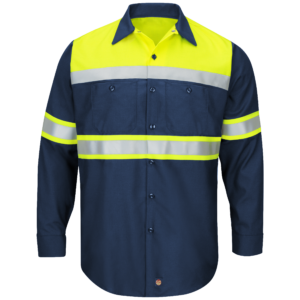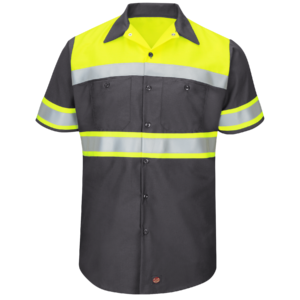In our post, What is ANSI 107, we covered the changes to ANSI 107-2010 and ANSI 207-2011. These two documents were combined to create a single, updated document, also known as ANSI 107-2015.
The new update detailed the changes and the importance of high-visibility apparel. Within those changes, came a simple classification system for high-visibility workwear.
These classifications aim to simplify the way to identify high visibility apparel needs, based on job. Those classifications are listed as Type P, Type R, and Type O.
Digging down into these new types, we have O, which stands for off-road and non-roadway use.
R refers to roadway and temporary traffic control zones. P refers to the public safety sector, which includes emergency and law enforcement personnel.
Red Kap says that adding the garment types O, R, and P makes high-visibility safety apparel more useful. This lets managers and safety experts deal with a wider range of possible dangers.
In this post, we will cover:
- What is Type O?
- What workers should be wearing a Type O garment
- The safety concerns with choosing enhanced visibility over Type O
- A Type O garment example
So let’s get started and understand this first of three classifications.
What is ANSI 107 Type O?
ANSI 107-2015 Type O is made for use in places where there are dangers from moving vehicles, equipment, and machinery that could hit people. These areas are not public access rights of way or temporary traffic control zones.
With Type O added to ANSI 107-2015, 12+ million new employees should now wear high-visibility safety clothing (HVSA).
Before Type O, transportation, utilities, and roadway construction were the prime industries for HVSA. However, type O brought high-visibility clothing to workers who weren't required to wear clothes that made them more visible.
So the question needs to be asked, who are these workers?
ANSI 107 Type O workers
With Type O added to ANSI 107-2015, it brought in new industries that HVSA should cover. This helped to avoid any possible penalties from OSHA for not following the rules. These industries and workers include the following:
Construction: Residential construction, non-residential construction, heavy civil engineering utility, heavy civil engineering land, other heavy civil engineering, specialty building foundation, specialty building equipment, specialty building finish, and specialty other.
Transportation: Trucking gen. Freight, trucking specialized freight, support water, support freight, and support other.
Utilities: Water/sewage
Administrative Support Services: Facilities support, investigation/security, and buildings/dwelling.
Police/Fire/Corrections: Correctional institutions.
Metal Manufacturing: Primary metal manufacturing, fabricated metal manufacturing, machinery manufacturing, and transportation equipment manufacturing.
Wood/Paper/Chemical Manufacturing: Wood manufacturing, paper manufacturing, petroleum and coal manufacturing, chemical manufacturing, plastics and rubber manufacturing, and non-metallic mineral manufacturing.
Food/Beverage Manufacturing: Food manufacturing and beverage/tobacco manufacturing.
Couriers/Warehousing: Couriers/Messengers and warehousing/storage.
The ANSI 107 Type O definition standards
Type O garments fall into Class 1 of ANSI 107 and are defined as having 217 sq. inches of background fabric with 155 sq. inches of reflective tape (1.0” wide) + design. By comparison, type O needs the least amount of square inches of background fabric, as well as reflective tape.
ANSI 107 Type O and your safety requirements
Looking at the oil and gas industry, these workers are usually found in enhanced visibility shirts. If you aren’t familiar with enhanced visibility, you can read more about it in this article.
Usually, a top that makes you more visible will have a plain grey or navy blue color and a one-inch-wide reflective stripe with high-visibility trim.
So what is the issue if these guys are just out and about on a well pad?
These clothes can make the worker more visible, but they don't show the worker when working against a background that matches their shirt's color.
This could be any piece of equipment that is usually found at a drill site. The other worker can't see the other worker backing up in a water truck or other machine that is moving around the work area.
This exact scenario played out when a young man was struck and killed by a truck backing up. So, how important is your safety apparel regarding the safety of your team?
ANSI 107 Type O apparel examples


When first looking at a Type O workshirt, it looks like a mix of high-visibility and enhanced visibility. This particular shirt is an upcoming Red Kap High-Visibility Ripstop Work shirt and features a color-block design.
For those working in off-road environments, this shirt has added visibility that you won’t find with enhanced visibility garments. It becomes the perfect choice when safety is your core value.
In conclusion, ANSI 107 Type O garments provide an added level of safety that off-road workers need. For companies that make safety their number one priority in company values, this will be a welcomed change. As a result, we should see less struck by incidents because of visibility issues.

Topics: Visibility
.png?width=621&height=373&name=Model-Apparel%20Logo%20File%20from%20Ian%20(1.2).png)
.png)
